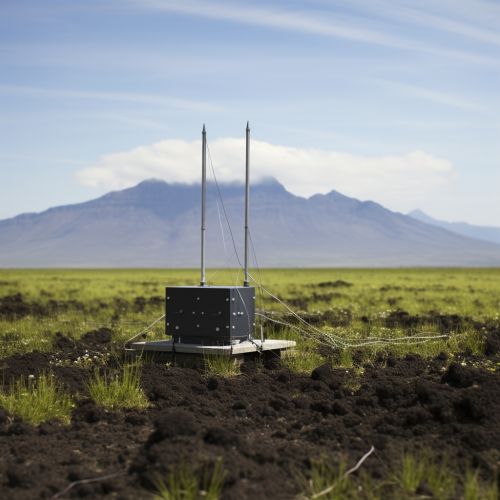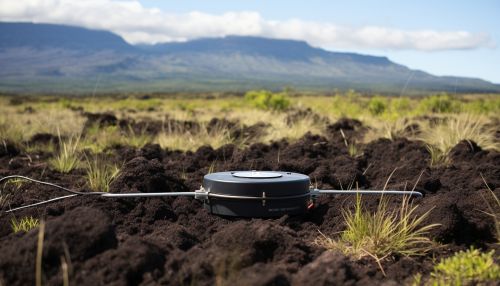Explosive Eruption
Introduction
An explosive eruption is a type of volcanic eruption characterized by the violent discharge of volcanic ash, gases, and other materials. Unlike effusive eruptions, which involve the gentle outflow of lava, explosive eruptions are driven by the rapid expansion of gas within molten rock or magma.


Causes
Explosive eruptions are primarily caused by the composition of the magma. Magma's viscosity, or resistance to flow, and its gas content are crucial factors determining the type of eruption. High-viscosity magma traps gases, leading to a build-up of pressure that is eventually released in an explosive manner.
Magma Composition
The composition of magma varies depending on its source material and the processes it undergoes within the Earth's mantle and crust. Magma that fuels explosive eruptions is often high in silica, a compound that increases the magma's viscosity. This type of magma, known as felsic or silicic magma, forms the basis for some of the most powerful and destructive eruptions.
Gas Content
The gas content of magma also plays a significant role in determining the explosivity of an eruption. Gases, primarily water vapor with smaller amounts of carbon dioxide and sulfur dioxide, are dissolved in the magma while it is under pressure beneath the Earth's surface. As the magma rises and pressure decreases, these gases come out of solution, forming bubbles. If the magma is viscous, these bubbles cannot escape and pressure builds up, leading to an explosive eruption.
Types of Explosive Eruptions
There are several types of explosive eruptions, classified based on their characteristics and the materials they eject. These include Plinian, Vulcanian, Strombolian, and Phreatomagmatic eruptions.
Plinian Eruptions
Plinian eruptions are the most powerful type of explosive eruption. They are characterized by the ejection of large amounts of pumice and ash into the atmosphere, forming a tall, stable eruption column. These eruptions are named after Pliny the Younger, who described the eruption of Mount Vesuvius in 79 AD.
Vulcanian Eruptions
Vulcanian eruptions are smaller than Plinian eruptions but still involve the explosive ejection of ash and volcanic bombs. These eruptions are named after the island of Vulcano in Italy, where such eruptions were first described.
Strombolian Eruptions
Strombolian eruptions are characterized by the ejection of incandescent cinder, lapilli, and lava bombs. These eruptions are relatively small but can occur frequently.
Phreatomagmatic Eruptions
Phreatomagmatic eruptions occur when water comes into contact with magma, creating steam and causing the magma to explode. These eruptions are characterized by the ejection of fine-grained ash and steam.
Effects of Explosive Eruptions
Explosive eruptions can have significant effects on the environment and human societies. These effects can be local, such as the destruction of landscapes and ecosystems, or global, such as climate change.
Environmental Effects
Explosive eruptions can drastically alter local landscapes and ecosystems. The ejection of large amounts of ash can bury landscapes, while pyroclastic flows can destroy everything in their path. Additionally, the release of volcanic gases can lead to acid rain and the depletion of the ozone layer.
Climate Change
Large explosive eruptions can impact the global climate. The ejection of sulfur dioxide into the stratosphere can lead to the formation of sulfuric acid aerosols, which reflect sunlight and cool the Earth's surface. This cooling effect can last for several years.
Human Impact
Explosive eruptions can have devastating effects on human societies. In addition to the immediate danger posed by pyroclastic flows and falling ash, eruptions can lead to long-term problems such as crop failure and water contamination. Moreover, the global cooling effect of large eruptions can lead to widespread famine and social unrest.
Predicting Explosive Eruptions
Predicting when and where an explosive eruption will occur is a major challenge in volcanology. Scientists use a variety of techniques to monitor volcanic activity and provide early warning of an impending eruption.


Seismic Monitoring
Seismic monitoring is a key tool in eruption prediction. As magma rises towards the surface, it causes small earthquakes. By monitoring these earthquakes, scientists can track the movement of magma and anticipate an eruption.
Gas Monitoring
Monitoring the gases emitted by a volcano can also provide clues about an impending eruption. Increases in the emission of certain gases, such as sulfur dioxide, can indicate that magma is nearing the surface.
Ground Deformation
The movement of magma beneath a volcano can cause the ground to deform. By monitoring these changes, scientists can gain insights into the location and volume of the magma.
Conclusion
Explosive eruptions are powerful natural events with significant impacts on the environment and human societies. Understanding these eruptions and predicting their occurrence are crucial tasks in the field of volcanology. Despite the challenges, advances in monitoring techniques and our understanding of volcanic processes are improving our ability to mitigate the risks posed by these destructive events.
